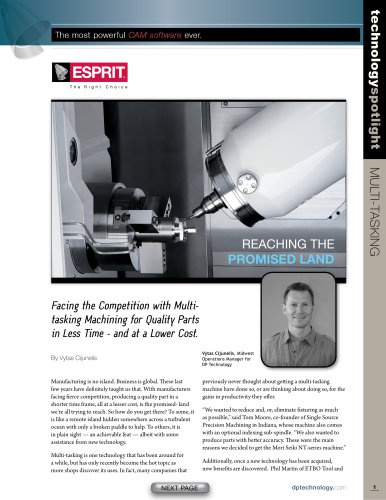 Website:
ESPRIT by DP Technology
Website:
ESPRIT by DP Technology
Group: DP Technology Corp.
Catalog excerpts
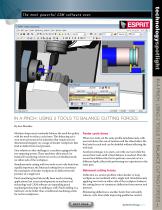
The most powerful CAM software ever. File Edit View Create Machining Analysis Tools Window Help A PINCH: USING 2 TOOLS TO BALANCE CUBING FORCES Machine shops must constantly balance the need for quality with the need to reduce cycle times. This balancing act is even more pronounced in industries that require precise dimensional integrity on a range of slender workpieces that tend to deflect from tool pressure. One solution to this challenge is a machine equipped with two opposing turrets. These machines allow pinch (or balanced) machining, where two tools cut simultaneously on either side of the workpiece. Simultaneously cutting with two tools is not only faster but, equally important, the balanced cutting forces counteract the inclination of slender workpieces to deflect from the pressure of a single tool. Pinch machining has historically been used in turning applications, but recent developments in machine tool technology and CAM software are expanding pinch machining technology to milling as well. Pinch milling on a mill-turn can be better than a traditional machining center Faster cycle times When two tools cut the same profile simultaneously, with one tool above the axis of rotation and the other below, the feed rate for each tool can be doubled without affecting the tool load. Another technique is to start a cut with one tool while the second tool waits until a fixed distance is reached. Then the second tool follows the first to perform a second cut at a different depth, effectively performing two operations in the same pass. Balanced cutting forces Deflection is a serious problem when slender or long workpieces are machined with a single tool. Simultaneously applying two tools on either side of the workpiece balances the cutting forces to counteract deflection from uneven tool Eliminating deflection is another factor that noticeably reduces cycle time while improving qualitative control. NEXT PAGE
Open the catalog to page 1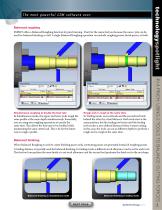
Balanced roughing ESPRIT offers a Balanced Roughing function for pinch turning. Don't let the name fool you because the same cycle can be used for balanced finishing as well. A single Balanced Roughing operation can include roughing passes, finish passes, or both. Project Manager J] Features \^\ Tools Operations Project Manager _^ToD_T^rret_ Botttom Turret ^SolidTurr ■ Eaa-cer Roughing Solid Turn - Balanced Roughing ^ | Features Tools S Operations |~ Simultaneous roughing at double the feed rate In Simultaneous mode, the upper and lower tools rough the same profile at the same depth...
Open the catalog to page 2
The most powerful CAM software ever. Project Manager Synchronizing operations on upper and lower turrets ESPRIT makes it easy to synchronize turning operations and tool changes in the Operation Manager. Drag-and-drop technology can be used to quickly create a sync before or after an operation or before or after a tool change. The Balanced Roughing function automatically creates two separate turning operations for the upper and lower turrets and synchronizes them in Balanced Roughing operations are synchronized in the Operation Manager The two operations also remain linked in a parent/child...
Open the catalog to page 3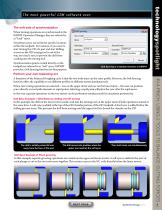
Soft Syncing is a standard function in ESPRIT When two turning operations are selected—one on the upper turret and one on the lower turret—the user can position syncs directly on tool path elements or rapid points. Selecting a rapid point will place the sync after the rapid move. In this way, separate operations on the two turrets can be performed simultaneously for maximum productivity. Soft Sync Example 1: Simultaneous drilling and OD turning In this example, the drill on the lower turret would crash into the turning tool on the upper turret if both operations started at the same time. A...
Open the catalog to page 4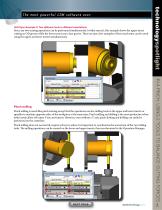
The most powerful CAM software ever. Soft Sync Example 3: Two different tools in different orientations Since any two turning operations can be performed simultaneously (within reason), this example shows the upper turret cutting an OD groove while the lower turret cuts a face groove. These are just a few examples of how much time can be saved using the upper and lower turrets simultaneously. Pinch milling Pinch milling is much like pinch turning except that the operations use live milling tools in the upper and lower turrets or spindles to machine opposite sides of the workpiece at the...
Open the catalog to page 5
This type of pinch milling is well suited for producing turbine blades since the blades are typically long, thin, and prone to deflection. When the blade is supported between opposing rotary spindles, the spindles can clamp and apply torque at both ends of the workpiece. Because the part can be held more rigidly and is subjected to far less deflection, allowable spindle load can be increased on both spindles. This configuration also permits the use of bullnose end mills., which can take wider passes than a ballnose without increasing cusp height. By keeping a bullnose tool normal to the...
Open the catalog to page 6All ESPRIT by DP Technology catalogs and technical brochures
-
ESPRIT Report Generator
2 Pages
-
ESPRIT General Overview Eng.
4 Pages
-
ESPRIT ProfitMilling
4 Pages





